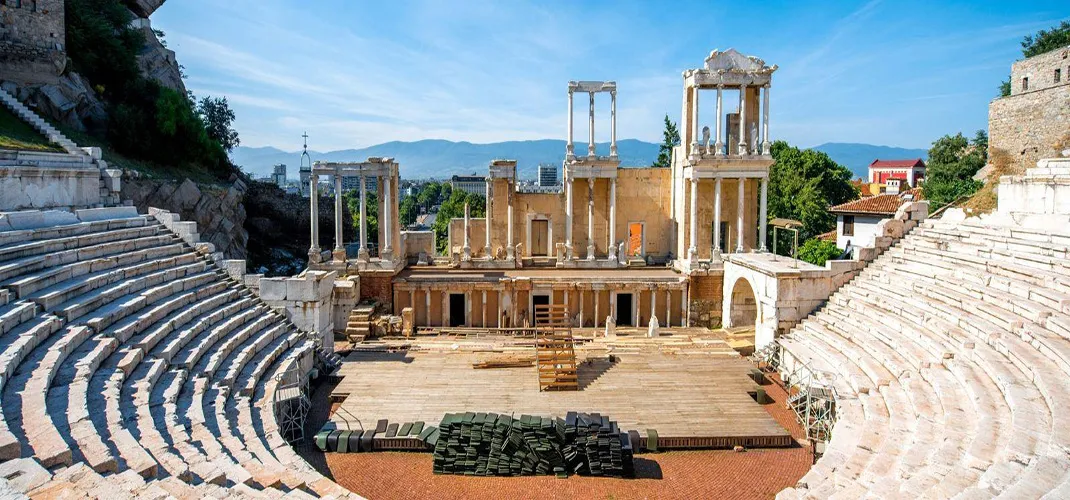Plovdiv

The iconic hills that surround Plovdiv and the city itself have been inhabited for over 8,000 years, making it one of the oldest inhabited cities in the world. The Ancient Thracians who were once in control for a few thousand years before the Romans took over, constructed a majestic ensemble of monuments that are still being dug up today. The Roman Theatre is one of the most complete you will see along with the city’s hillside Old Town, an openair Museum, which is littered with ancient Churches and Mansions built by wealthy merchants.
While in Plovdiv there is some fine Bulgarian cuisine to be found. If you go to a Bulgarian Mehana there will be traditional dance performances from a stage or courtyard while you eat. Dinner is normally a time for huge cuts of chargrilled meat, clay pot stews, mushrooms on skewers, halloumi cheese, yoghurt and fresh shopska salad made with tomatoes, cucumbers, onions and peppers. And for those who are wanting to try the local drinks there are two to try. The first is a powerful Rakia, which can be enjoyed across most of the Balkan countries and then there is the Thracian Lowland wine region, which offers an indigenous Mavrud red grape wine.
The Ancient Theatre is one of the world’s most intact sites, which is still being used 2000 years after it was constructed. The structure cuts into the side of Taksim Tepe, one of Plovdiv’s six hills. Stepping down the slope towards the terraces you will have amazing views of the City and the Rhodope Mountains. In the summer time there might be an opportunity to see an Opera or Theatre performance at this wonderful site.
Plovdiv’s Old Town is full of cobblestone streets, where you will see Roman ruins mixed amongst traditional homes. Most of the houses are on Ulitsa Saborna and are half-timbered with some painted in vivid colours. The House on Stepan Hindliyan, dates back to the mid-1800’s, which is blue with characteristic delicate Sgrafitto designs around its window frames. Inside the house the murals in just one room in Stepan Hindliyan’s House took six months to paint by hand!
Founded in 1083 the Bachkovo Monastery lies just outside the town of Asenovgrad. The Bachkovo Monastery is the second largest and oldest Eastern Orthodox Monastery in Bulgaria and brings together Bulgarian, Georgian and Byzantine religious traditions. The oldest part of the original complex is the Ossuary, a few hundred metres from the main buildings. Here you will find frescoes from the 1300’s, one depicting Tsar Ivan Alexander of the Second Bulgarian Empire. Inside the Holy Virgin Church there is even an icon of the Virgin Mary that was brought here from Georgia in the early 14th Century.
The Plovdiv Roman Stadium once seated 30,000 spectators back in the 2nd Century. Unfortunately, today you can only see fragments of this structure today. Sitting beneath a part of Plovdiv’s Old Town it was only excavated in the 20th Century. If you want some great views head to Dzhumaya Square where you can look over the railings down to a large section of the stadium’s seating.
Another major attraction is the Ethnographic Museum set in another merchant’s house built in the mid-19th Century, this one belonged to Argir Kuyumdzhioglu who was originally from Bulgaria. As you enter the building you will see the ornate Baroque Sgraffito and the undulating curves of the building’s roof. The Museum has collected more than 40,000 items relating to Bulgarian folk culture over the centuries including musical instruments, handicrafts, fabrics and clothing.
Situated next to Plovdiv’s post office are the remnants of the City’s Roman Forum, the Ancient Philippopolis, which crossed the two main streets of Cardo Maximus and Decumanus Maximus. Today, you can see the evocative pieces of Doric Columns. Next door is the Odeon where Plovdiv’s Council would have met, underlining the city’s importance to this region.
A short journey southeast of Plovdiv is the Asen’s Fortress a Medieval Castle that teeters on the edge of ridge over the Asenitsa River. This impressive building looks stark against a landscape of limestone rocks and pine brush. The walls of the Fortress weave down the precipitous mountainsides, guarding a perch that has been a stronghold for as long as 6,000 years, back to the time of the Thracians. Today, what we see here is from the 1200’s with the best-preserved section being the Church of the Holy Mother of God with beautiful if partially damaged murals dating back to the 14th Century.
A section of the Acropolis is one of Plovdiv’s oldest pieces of Christian heritage dating back to the 4th Century, the Church of St. Konstantin and Elena. The records show that it was constructed around 30 years after the martyrs Severin and Memnos were decapitated on this spot for their Christian faith when paganism was still prevailing. The interior is from the 1800’s Bulgarian National Revival and is decorated in a lavish Neo-Baroque style.
